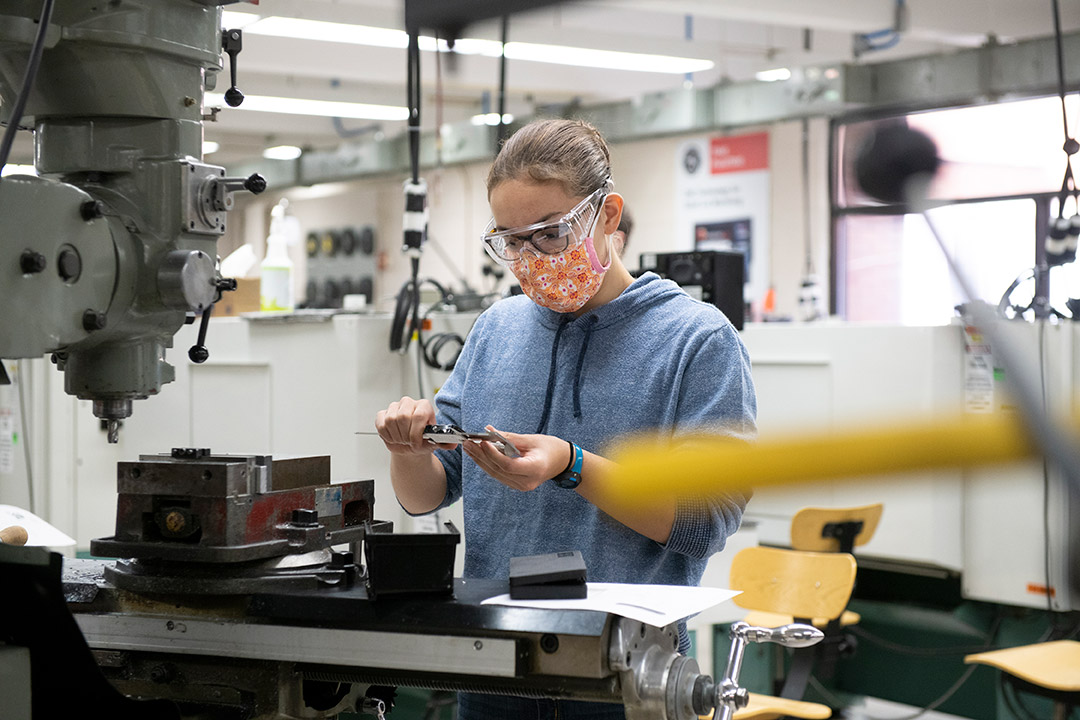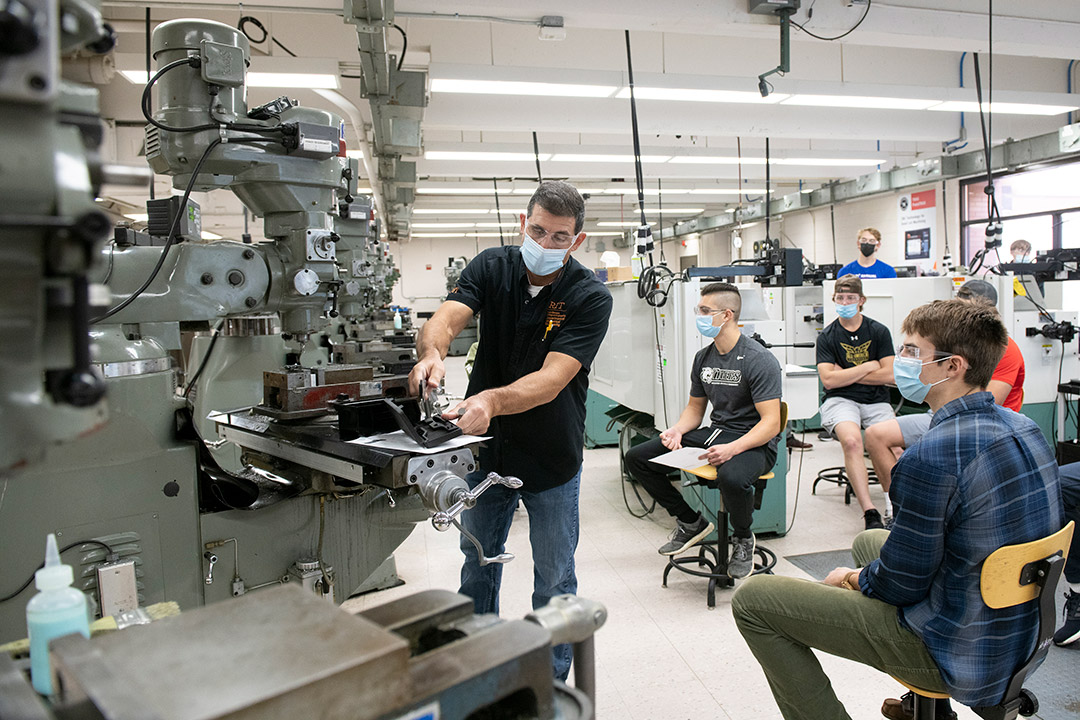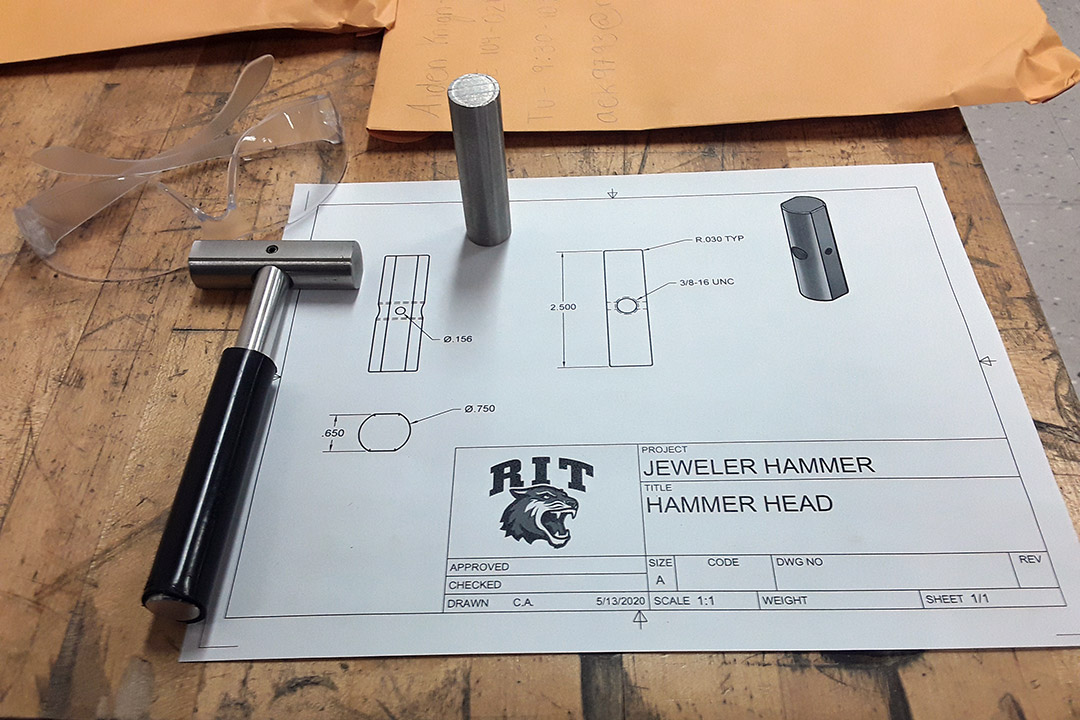Batteries included: Engineering Design Tools class transitions from fully onsite to mixed-class structure because of pandemic
First-year students still able to learn hands-on mechanical skills
A. Sue Weisler
Zoe Masters, a first-year engineering student from Webster, N.Y., calibrates her device after precision milling during the Design Tools class taking place in the Machine Shop, part of RIT’s Kate Gleason College of Engineering.
Engineering Design Tools, a first-year course, is an example of how RIT’s most applied programs have managed to keep learning as close to hands-on as possible in the age of COVID-19.
Mechanical engineering faculty and lab managers modified the course this summer to prepare for the new environment posed by the pandemic. They added a take-home kit of parts, adapted the structure of the class to include onsite and online collaborations, and retained the most important engineering concepts, said John Wellin, one of four faculty co-teaching the course.
A. Sue Weisler
Jan Maneti, operations manager of RIT’s Machine Shop, demonstrates milling techniques as part of the class design project. Faculty and staff in learning labs such as the Machine Shop have installed cameras for students to watch close-up demonstrations streamed onto a screen in the shop to meet the distance requirements due to the COVID-19 pandemic.
“This course gives a flavor of the engineering design process to freshmen to excite them about mechanical engineering and to see what is involved,” said Wellin, a senior lecturer in RIT’s Kate Gleason College of Engineering. “What they take away is that all these things they learn going through their career at RIT, in all their courses, this course can give them tools to fit into that narrative and the jobs that they will eventually be doing.
Logistical challenges met
Wellin; Mario Gomes and Kate Leipold, both senior lecturers in mechanical engineering; and Jan Maneti, operations manager of the engineering college’s Machine Shop, teach engineering theory and processes, CAD design, and precision milling to 210 first-year students in several course sections. In previous classes, there were approximately 140 students split into 36 teams of four. The larger number of students reflects good news—an increase in new students overall to the engineering college, especially in mechanical engineering, this fall. But it has also created some logistical challenges.
“We went from 36 kits to 210,” Gomes explained. Kits were ordered for each student instead of for each group, and distributed during onsite classes. Others were shipped to quarantined students at the start of the semester, or to those who requested all online class accommodations. In the past, there was a team project. This fall, it became an individual-build assignment, supplemented with a team consultation element during online class times.
“Learning about the hardware and troubleshooting is a key component of this course. Altering that, we felt couldn’t be done,” said Gomes. “They also have to look at issues of design and understand iterations because the design process is cyclical. There are also areas that have been expanded, some of the technical content around motors and gear boxes, for example.”
McGuyver-like, all students are expected to build a robo-monkey, a device that climbs. Teams must demonstrate that their device can lift itself over a meter in less than 120 seconds. Students will do this with a combination of gear boxes and batteries included in their kits along with safety glasses and some arts and craft items such as popsicle sticks, straws, pipe cleaners, wires, string, rubber bands, switches, Allen wrenches, and zip ties.
Formatting schematics for a climbing device starts with computer-aided design, or CAD programming. Leipold conducts her class fully online.
“I do a synchronous lecture each week, then students have signed up for small group labs with teaching assistants,” she said. “Previously, these sessions were larger groups with several TAs. Going online allowed more flexibility in scheduling, and hopefully the small groups foster more interaction.”
Onsite classes modified
Producing prototypes is necessary as students continue through upper-level classes including senior design. With training in formatting tool designs, students also learn about using milling and lathe equipment.
Manetti teaches students to handle materials for in-class projects, but standing close together as he explains the complex milling process is a thing of the past. Today, students watch him from safe distances. Demonstrations are also video-streamed onto a screen in the shop to be sure the intricate detail work is seen from all angles.
“Usually students can be closer, watching demonstrations and their classmates working,” said Manetti, who oversees the shop that is used for teaching, corporate training, and research. “With COVID, we needed to have that distance, but the shop is big enough and we can do this.”
Students learned how to use equipment in the Machine Shop and read design specifications to fabricate a jeweler’s hammer.
For many of the first-year students, it is their first time working on the machines, and each class about materials, precision machining, and fabricating builds on the previous one.
“We did a first pass of this work last week and today’s assignment was the real work to see if our design is accurate,” said Austin Goldinger, a first-year student from Pennsylvania. He and two classmates, Camryn Munro and Zoe Masters, concentrated on the detail work needed to drill an opening in a cylinder of stainless steel for the center portion of a jeweler’s hammer.
Learning outcomes retained
Multidisciplinary work such as engineering is as much about the final product as it is about how the team negotiates its way to that end goal, said Gomes.
“With a team, you divide up some of the responsibilities. Now, we know that whatever we ask of them, they will be doing individually, so that is good,” he said.
Wellin agreed. “This final design project is really the ultimate expression of how much they have incorporated of the concepts and how they dealt with issues of trouble-shooting, and understanding the ‘it never goes right the first time’ scenario. Before, that was in a team, and there were some who really got into it, and some who were indifferent to and others who just didn’t do it. Now we will have a measure of that for every student.”









